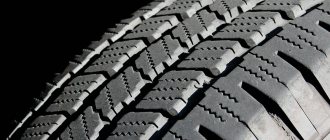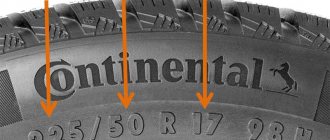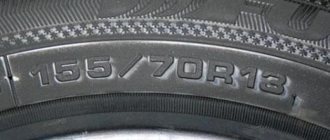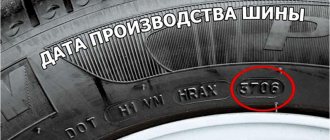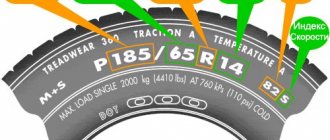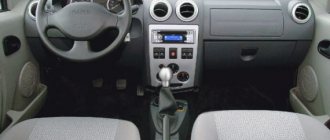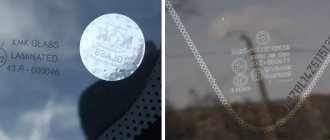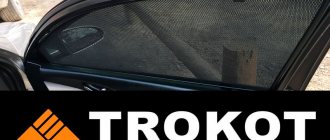Home / Articles
12.10.2013
The choice of car tires is always a crucial moment in the life of every motorist. But to independently select the right car tires, you need to know the design features and understand the main markings that are applied to each car tire.
The following combinations of designations of the main parameters are accepted on all car tires:
European standard
For the European type of marking, the following basic designations are used:
- brand name;
- purpose or operating features, for example, for off-road tires and all-wheel drive vehicles, “4x4” is indicated;
- markings showing information about the design;
- country of origin of the product (not brand registration, but the location of a specific manufacturing plant);
- tire size - width in millimeters, profile height (indicated as a percentage), seat diameter and type of construction (radial R, diagonally belted B or diagonal D), a special designation is used for truck tires and low-profile tires for armored vehicles;
- load and speed indices.
Additional markings according to the European scheme include:
- designation M&S or M+S (used for tires that can be used in mud and slush in winter weather);
- ASTM F-1805 mark - indicates that the rubber has passed a special winter test for grip quality;
- sign of the outer side of the tire (only for tires where the mounting side matters);
- CP certification with product compliance number EHK30;
- on the inner perimeter of the wheel rim, the amount of compound layer in the tread area and sidewall is indicated;
- DOT marking indicating the manufacturer;
- sign of the load index (carrying capacity) MAX LOAD, maximum pressure MAX PRESSURE;
- tire chamber type: tubeless Tubeless (TL), chambered Tube Type (TT or Tube).
The direction of wheel rotation, adhesion coefficient, limits of fatigue, strength and wear resistance, TWI wear indicator, date of manufacture and others may also be indicated.
Since 2012, in accordance with European marking requirements, a special sticker has been required on tires. It shows characteristics such as wet grip, fuel efficiency and acoustic comfort.
The fuel efficiency index shows the consumption during constant use of the vehicle and the value of rolling resistance. At the same time, the D index is used only for truck tires; it is prohibited to put similar tires on passenger cars and light trucks.
The value of wet road adhesion - this indicator is necessary to determine traffic safety and protection against hydroplaning during precipitation. Tires marked DG are not used in accordance with regulations.
Acoustic comfort is indicated by the number of schematic waves. The first two types characterize quiet and moderately noisy tires that can be used within the city. The latter type has been banned in Europe since 2016.
The new requirements do not apply to the following types of tires:
- with a welded tread (retreaded tires);
- racing (special high-speed, sports) tires;
- off-road specialized tires;
- studded tires or models designed for mounting hooks;
- spare tires intended for occasional use only;
- models with a speed index of up to 80 km/h;
- specialized models for motorcycles.
Additional Information
When labeling tires, manufacturers sometimes provide additional information about the qualities and characteristics of the products:
- TUBELESS – tubeless tire.
- TUBE TYPE (or TT, on German tires they write Mit Schlauch) - a tire that requires the installation of a tube.
- PR – ply rate. For passenger car tires, its value is usually 4PR or 6PR. The inscription Reinforced in this case means “reinforced” (has 6 layers). If the tire has a ply rating of 6PR or 8PR, then it can be used in small trucks, vans or minibuses (commercial, has 8 plies).
- Country of manufacture - in addition to the name of the manufacturing company, the country of manufacture is sometimes indicated.
- Designation of the outer and inner sides - if the tire is asymmetrical, then the word OUTSIDE (sometimes Side Facing Out) will be written on the outer side, and INSIDE (sometimes Side Facing Inwards) will be written on the inner side.
- Left or Right - in the first case, the tire can only be installed on the left side of the car, in the second - only on the right.
- Direction of rotation - for this use the word Rotation and an arrow indicating the direction of rotation of the wheel when moving forward.
- XL (Extra Load) – reinforced tire.
- Steel – metal cord. If this inscription is not present, then a textile cord is used. The designation All Steel corresponds to the fact that metal cord is used in both the frame and the breaker.
- DOT X0 (Department of Transportation, US Department of Transportation, X0 - tire manufacturer code) - American quality standard.
- Plies: tread – composition of the tread layer.
- Sidewall – composition of the sidewall layer.
- DA or Secunda (in the form of a stamp) - such seals are placed on tires that have received minor defects during the production process that do not interfere with normal operation.
- Green X, Reduces CO2 – this is the designation for rubber that has a low level of rolling resistance, which helps reduce fuel consumption and CO2 emissions (the so-called “green tires”).
- ND (Non Directional) – a tire with a non-directional tread pattern.
- NHS (Non Highway Service) – tire for low speeds.
- SAG (Super All Grip) - all-terrain tires.
- SUV (Sport Utility Vehicles) - tires for crossovers, sports SUVs and heavy all-wheel drive vehicles.
- REGROOVABLE – the ability to deepen the tread pattern by cutting.
- RETREAD – the tire has been used and retreaded.
- Studless - cannot be studded.
- Studdable - subject to studding.
- Studded - studded tire.
- GOST or TU - on domestic tires they write the number of GOST or technical conditions in accordance with which the product was manufactured.
- ZR – high speed tires.
- The letter E in a circle means the tire meets the European requirements of ECE (Economic Commission for Europe).
- ECE - alternative mark of conformity to EEC - e11
Colored marks in markings
Manufacturers often use color markings in the form of circles and triangles.
What does the color of the tire markings mean:
Yellow
The marker is located on the side. Shows the lightest place in the tire. The yellow marker must be combined with the heaviest place on the disk - with the nipple (spool).
American standard
American labeling standards are similar to European ones, but there are differences. So, on the side surface the target accessory is indicated:
- passenger tires Passanger "P", used for passenger cars;
- light trucks, designated LTP or LT (Light Truck Personsl and Light Truck, respectively);
- Temporary "T" spare wheels.
The load index according to American marking is indicated in inches, this is the LBS sign. Pressure indices are indicated by the PSI sign. For SUVs, the standard size is also indicated in inches; such parameters as external diameter, tire width, tire design and internal diameter parameters are required.
P 185/65 R14 86 N
P 185/65 R14 86 H
- P – designation of the type of vehicle for which these tires are intended. “P or Passanger” - passenger car, “LT or Light Truck” - light truck, etc.
P 185/65 R14 86 N
- 185 – value of the tire profile width, mm.
P 185/ 65 R14 86 N
- 65 – the value of the tire profile height, measured as a percentage of the width. If a standard size without height is specified, for example 175 R13, the height is assumed to be 80-82% (full-profile tires).
What do the colored marks mean?
New tires from the factory often have special color markings in the form of stripes or geometric marks. It is applied for a specific purpose and is used for proper maintenance.
The following types of color marks for automobile rubber are accepted:
- yellow marks in the form of triangles or circles indicate the lightest areas on the tire; when balancing, such a mark is aligned with the heaviest place on the rim, achieving optimal performance;
- red marks in the form of triangles and circles on the side of the tire indicate points of force heterogeneity, usually applied to the tires of the original equipment of the car;
- longitudinal lines on the tread are used for easy identification when storing tires;
- stamps in the form of white triangles and circles are personal markers of the inspection inspector, who performs a final inspection of the product before going on sale.
Date of manufacture
Even without being installed on a car, rubber loses its properties over time. If tires are stored in a warehouse for a long time, they lose their elasticity and, accordingly, their driving characteristics.
You can calculate the tire's release date by looking at the DOT marking. The last 4 digits of the American code, enclosed in a semi-oval, indicate the week and year of production. For example, if this number is 2216, then the tire left the factory in week 22 of 2016.
Types of designs and designations
One type of rubber marking is the designation of the type of construction. Depending on the manufacturing method and design, radial tires R and diagonal tires D are distinguished. The designation is placed in front of the diameter; the difference lies in the location of the tire cords. In the first case, they run parallel to each other, in the second - at an angle of 45-60 degrees relative to each other. A third type is also produced - diagonally encircling, but in most cases today radial tires are produced.
The second type of marking to determine the wheel design is the following:
- reinforced Extra load (XL), which is also sometimes designated REINFORCED;
- self-supporting Run Flat (RFT), maximally protected from punctures or cuts, can travel up to 80 km if damaged without loss of speed or skidding.
All-terrain tires labeled All-Terrain stand out separately. This sign should not be confused with the inscription Reinforced (RF), which is used for passenger tires with reinforcement; these are different types of products intended for different conditions. The presence of the designations 6PR and 8PR indicates that this is a light truck tire; the C (commercial) mark is applied to tires for commercial use.
How else does the manufacturer label tires?
- TREADWEAR - wear resistance index. Indicates the degree of wear resistance and can range from 100 to 500 units or more. The higher the indicator, the slower the tires will wear out, but this largely depends on driving style, the quality of the road surface and weather conditions.
- Temperature (temperature indicator) . Indicates the heat resistance of the rubber at high speeds. There are 3 types: A, B and C, in which A is the best indicator, and C, accordingly, the worst.
- “MaxPressure” is the highest pressure indicator inside the wheel. It is expressed in kilopascals (kPa) or bars.
- Reinforced - reinforced rubber. Talks about strengthening the tire using an additional layer of cord or other auxiliary elements.
- Installation exclusively on the front axle is indicated by the letter “F” or the phrase “Frontwheel”, on the rear axle - by the inscription “Rear wheel” .
- Sometimes the factory specifies the material from which the tires are made. For example, the inscription “2 POLYESTER CORD + 2 STEEL CORD” means that the rubber has 2 layers of polyester cord and 2 layers of steel.
Speed, load and pressure indices
When marking tires, immediately after specifying the standard size, speed, load and maximum permissible pressure indices are also indicated. LI is the load capacity value; in some cases, instead of a letter index, Max Load is indicated, that is, the maximum load is allowed, followed by a double digit (the value is given in kilograms and pounds). This value must be taken into account when choosing tires for the front and rear axles, since some manufacturers provide completely different parameters for installation. All tire manufacturers publish tables with load values, and the recommended figure is also indicated in the specification for the car, so choosing the right model is not difficult.
SI is a speed index that shows the maximum possible safe speed. If the indicator is acceptable, the operation of the rubber will correspond to the declared characteristics. The load index is applied to the tire in the form of a letter marker. For example, J – maximum speed 100 km/h, K – 110 km/h, M – 130 km/s, S – 180 km/h, T – 190 km/h, Y – 210 km/h and others.
The pressure index is designated PSI; it shows optimal internal pressure indicators that ensure fuel efficiency, comfort and driving safety. If the pressure is too low, fuel consumption increases, wear increases, and the tire angle also changes, which negatively affects driving safety. Reduced pressure causes the temperature inside the wheel to increase, that is, rolling resistance increases. A similar situation is observed during pumping, when the ride becomes extremely uncomfortable, hard, tire wear increases, and there is a risk of damage and an emergency.
DELETEIIIIIIIIIIT
For example, we will decipher the marking of a tire on which the manufacturer has applied the following code: 195/70 R14 88 T M+S - what do these numbers on the wheel mean? Let's figure it out like this:
We look at the top of the tire in the illustration and decipher the marking 195/70 R14 88 T M+S, applied to the sidewall of the tire:
- 195 is the width of the tire section in millimeters.
- 70 - This number represents the "tire height" as the ratio of the profile height to the tire width - 70%. Most often, this parameter is called a profile (for example, full-profile or low-profile tires), with the same tire width, the larger this indicator, the taller the tire. When choosing a set of tires, it is important to take into account the permissible sizes declared by the car manufacturer. And also remember that if the tire profile height is lower than optimal, the vehicle’s ground clearance will become lower, but the use of larger profile tires is limited by the size of the wheel arches, especially in winter, when the arches are often clogged with snow and ice. Almost any online store of tires and wheels has a special tire calculator that allows you to choose the appropriate tire size for a particular car model.
- R - this symbol means that the tire is made with a radial cord; almost all tires currently are made with just such a cord. Some motorists mistakenly believe that R stands for tire radius, but this is precisely the radial design of the tire.
- 14 - this number indicates the diameter of the disk (rim) in inches. Not the radius (by the way, also a common mistake), but rather the “fitting” (inner) diameter of the tire on the disk, which in this case is 14 inches.
- 88 - this number indicates the index of the maximum permissible load on one wheel (in this example, it is 560 kg per wheel, so tires with this index are quite suitable for a passenger car weighing up to two tons). It is especially important to choose the correct load index when purchasing tires for minibuses and small trucks.
- T - This symbol indicates the speed index of the tire and in this example the tire speed is limited to a maximum value of 190 km/h.
- M+S is a tire marking (M&S = Mud + Snow / mud + snow), which means that the tires are winter, they are also called “all-season”, since they do not put studs on such tires, and you can, in principle, use such wheels all year round, there is no fine for such tires in the summer. It often happens that SUVs are sold equipped with M+S tires; depending on the driving style and weight of the car, such tires can last more than 50,000 kilometers.
Now let's look at the reference data that will help you decipher the markings on the tires for your vehicle.
Seasonal marking
In addition to the main technical characteristics, tire markings indicate seasonality. There are three groups - winter with spikes and without hooks, summer, all-season.
Summer tires do not require special markings; general designations are used. For all-season vehicles, pictograms depicting the sun, snow and rain are used; signs such as AW (All Weather), AGT (All Grip Traction) or AS (All Season) may be indicated. In some cases, the Rain sign is additionally indicated, that is, the rubber belongs to the rain class.
Winter tires are marked with a pictogram in the form of a snowflake, the words Winter or M+S (Mud + Snow). Such designations allow you to determine for which conditions the rubber is most suitable. The presence of additional signs in the form of an umbrella and the words Aqua, Aquatred, Water, Aquacontact, Rain indicates that the tire is resistant to hydroplaning.
Tread pattern type and markings
Separate markings are used for tires with a specific tread pattern. There are three types - with directional, asymmetrical and non-directional patterns.
Rubber with a directional tread has excellent behavior on wet roads, quickly removes water from the contact patch and reduces the risk of aquaplaning. For such tires there is always a Rotation marker showing the direction of rotation. It is impossible to rearrange the wheels without taking this sign into account, since an incorrect position will cause an emergency situation on the road even in light precipitation.
The non-directional pattern is universal and does not require special designations. Often these tires are installed by factories on different types of cars and act as complete tires.
The asymmetrical design features a combined pattern. On the right is the “rainy” part, on the left is the “dry” part. This means that the stiffness of the outer and inner sides is different, as is the ability to absorb load. Therefore, such tires always have special markings:
- for the inside – Outside or Side Facing Out;
- for the outside – Inside or Side Facing Inwards.
Symbols for correct rubber installation
In addition to deciphering the inscriptions on tires, the second most important are special symbols that allow you to correctly mount the tire.
Rotation
This symbol can be present in the form of an inscription or an arrow. It shows the direction of rotation of the tire. If you put the arrow in the other direction, the rubber will experience increased wear and will quickly fail.
Outside
An important indicator for tubeless tires. Translated from English, the word means “external”. This means the side of the rubber that should be on the outside. Otherwise, such a tire will not hold pressure.
Inside
If there is an external side, then there is also an internal side. This is also used in conjunction with the previous designation.
Outer and inner side of the tire
It is important to ensure that the direction of the rubber and the installation rules are followed at the tire shop.
Date of issue
Any rubber product has an expiration date. After this period, the rubber becomes hard, cracks and loses its properties. The same thing happens with tires: the older the tire, the greater the chance that it will burst while driving. To calculate whether the rubber is suitable for further use, you need to know the date of its manufacture, which is stamped in two ways:
- In the form of three numbers - an outdated version.
- In the form of four numbers - a modern version.
In the first version there is an oval, inside of which there are numbers. The first two digits are the week of manufacture, the last one corresponds to the final digit of the year. For example, 469 means the tire was produced in November 2022 or 2009.
Problems with deciphering the year led to a new version of the production date. Now it is printed as four numbers in the same oval. The first two digits are the week, the second two correspond to the year.
What does homologated tires mean?
Additional marking of tires includes an alphanumeric index indicating for which car brand the tires are homologated. This is an indicator that these tires are produced specifically for installation on certain cars, for example, Toyota or Mercedes. Therefore, when choosing, it is important to pay attention to the presence of the following indices:
- Oh, MO1 – for Mercedes cars, the first type can be used for cars of other brands;
- N0- N3 – only for Volkswagen Touareg and Porshe, Installation on other vehicles is not recommended;
- AO – for installation on Audi;
- A – for the Toyota Auris model;
- * — installation on BMW is recommended.
Choosing the right tires is not only about choosing a model of a certain brand with the right size. This takes into account parameters such as seasonality, design features of tires, permissible loads or speed limits. All the necessary information is applied to the sidewall of the tire, which makes it easier for the car owner to make a choice and allows him not to make a mistake when purchasing.
